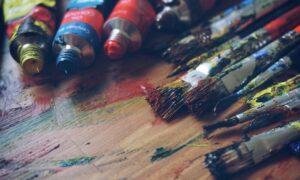To clean oil painting brushes, you will need a container of mineral spirits or turpentine, a bar of soap, and some paper towels or a clean rag. Follow these steps:
Dip the bristles of the brush into the mineral spirits or turpentine and swirl it around to loosen the paint.
Correct! This is the first step in cleaning oil painting brushes. The mineral spirits or turpentine will help to loosen and dissolve the paint, making it easier to remove. Just be sure to use these solvents in a well-ventilated area, as the fumes can be harmful if inhaled. And it is a good idea to wear gloves to protect your skin.
Rub the bristles against the bar of soap to create a lather. This will help to remove any remaining paint from the brush.
Yes, that’s right! After dipping the brush in mineral spirits or turpentine, the next step is to create a lather by rubbing the bristles against a bar of soap. The soap helps to lift the paint from the bristles and can also help to clean and condition the brush. Just be sure to use a soap that is specifically designed for cleaning oil painting brushes, as regular hand soap or dish soap can be too harsh and strip the bristles of their natural oils.
Rinse the brush under running water to remove the soap and paint.
Exactly! After creating a lather with the soap, the next step is to rinse the brush under running water to remove the soap and any remaining paint. Be sure to hold the brush under the water with the bristles facing downwards, so that the water flows from the base of the bristles toward the tip. This will help to prevent the water from getting into the ferrule (the metal part that holds the bristles in place) and cause the glue to loosen.
While rinsing the brush, you can also use your fingers to gently squeeze the bristles to help remove any excess soap and paint. Just be sure not to apply too much pressure, as this can damage the bristles.
Use your fingers to gently reshape the bristles.
After rinsing the brush, you should use your fingers to gently reshape the bristles. This will help the brush to retain its original shape and ensure that it is ready for use in your next painting session. To reshape the bristles, simply run your fingers gently through them, starting at the base of the bristles and working your way toward the tip. You can also use a clean, dry towel to help reshape the bristles by gently patting them into place. Just be sure not to apply too much pressure, as this can damage the bristles.
Wipe the brush on a paper towel or clean rag to remove any excess water.
After reshaping the bristles, the next step is to wipe the brush on a paper towel or clean rag to remove any excess water. This will help the brush to dry more quickly and prevent it from becoming waterlogged, which can cause the bristles to become misshapen or even fall out. Simply hold the brush by the ferrule (the metal part that holds the bristles in place) and gently blot the bristles on the towel or rag, being careful not to apply too much pressure. You can also use a hair dryer in a low or cool setting to help speed up the drying process.
Leave the brush to air dry, laying it flat on a clean surface with the bristles facing upwards.
After wiping the brush to remove excess water, the final step is to leave it to air dry. It’s important to lay the brush flat on a clean surface with the bristles facing upwards, as this will help the brush to maintain its original shape and prevent the bristles from becoming misshapen. Avoid stacking the brush on top of other brushes or objects, as this can cause the bristles to become bent or damaged.
It’s also a good idea to avoid placing the brush in direct sunlight or near a heat source, as this can cause the bristles to become stiff or brittle. Instead, allow the brush to air dry in a cool, well-ventilated area. Depending on the size and thickness of the bristles, the brush may take anywhere from a few hours to a full day to dry completely.
Remember to always use mineral spirits or turpentine in a well-ventilated area and avoid breathing in the fumes. It is also a good idea to wear gloves when cleaning oil painting brushes to protect your skin.
